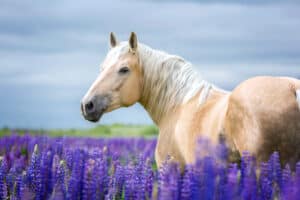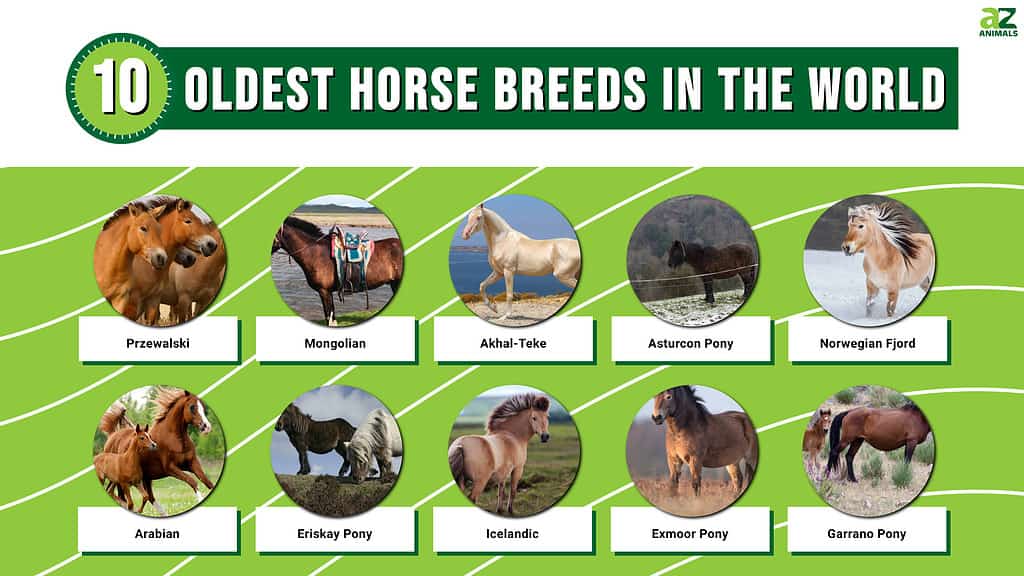
Horses were one of the last livestock species to be domesticated. Today there are more than two hundred different breeds of horses that all originated from the same ancestor. Let’s discover the 10 oldest horse breeds in the world and discuss some details about each type of animal.
The first horses were domesticated in the Eurasian steppes around 5,500 years ago. There is no evidence of a human on horseback until its appearance in Mesopotamian art at least a few hundred years after the first evidence of domestication.
The first evidence of a close human and horse relationship comes from the Botai in Northern Kazakhstan. They milked horses, ate their meat, and most likely domesticated them for the first time. Horses originally evolved in North America in the late Pliocene and spread across the world.
Without a human interest in horses, they most likely would be extinct. As the plains shrunk and Europe became forested at the end of the last Ice Age, horses were pushed out to the Eurasian steppe. In the Americas, native wild horses went extinct because they weren’t domesticated.
What breeds have been around the longest? We’ll discover the 10 oldest horse breeds in the world now.
10. 500 Years As a Breed: Garrano Pony
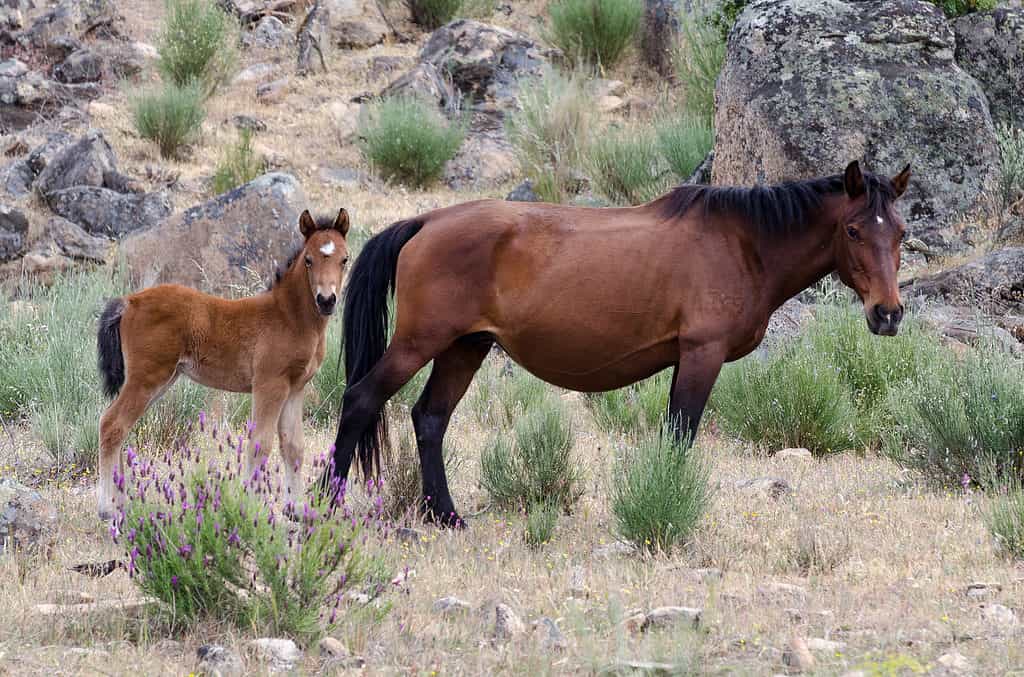
Garrano ponies are a semiferal Portuguese breed that reaches up to 13 hands in height.
©David Wieczorek/Shutterstock.com
Garranos can be officially dated back to the 15th century since they are the direct ancestors of more recently developed New World breeds. Garrano ponies are a semiferal Portuguese breed that reaches up to 13 hands in height. Celtic ponies were most likely brought to the Iberian Peninsula around 3,500 years ago, and these individuals gave rise to today’s Garrano ponies.
They’re quick learners that like to work. Garranos have a friendly demeanor and are usually a chestnut color with white markings.
Their population is quickly declining, with their main predator being wolves. There are a little over 2,000 wild individuals left today, and they are all found in the mountains of northern Portugal.
9. 900 Years As a Breed: Exmoor Pony

Exmoor ponies are rarely more than 12 hands tall.
©Wildpix productions/Shutterstock.com
The Exmoor pony was first recorded a little over 900 years ago. It comes from the region of England with the same name. They are most likely the descendants of ponies released during the Roman invasions, known as Celtic ponies.
They are rarely more than 12 hands tall. There are large captive-bred populations, and a small group of wild individuals remains in their home range. Sometimes wild ponies are taken to breed with captive animals to maintain desired characteristics.
8. 1,000 Years As a Breed: Icelandic Horses
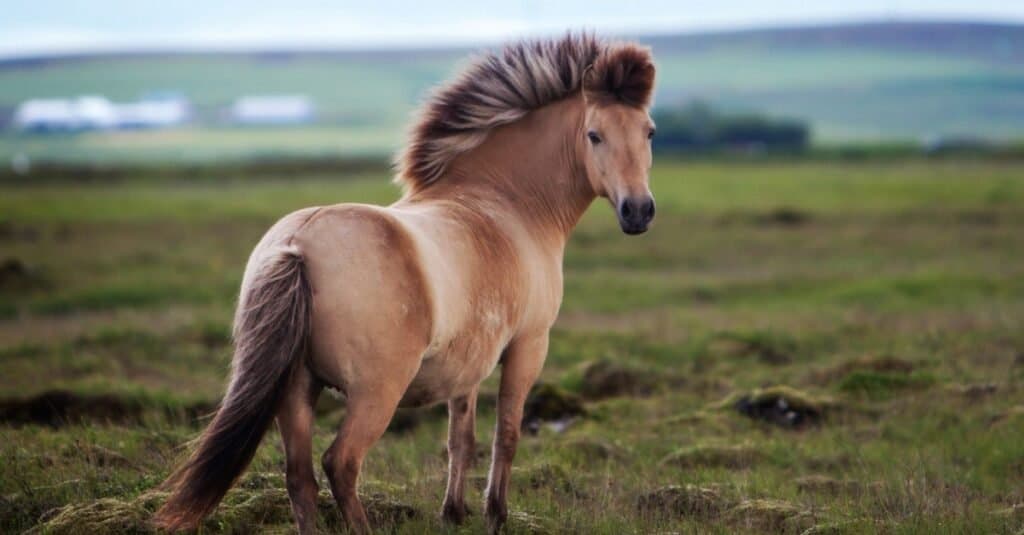
Icelandic horses are known for their sure-footedness and are lauded because they handle rough terrain well.
©iStock.com/zysman
Icelandic horses have been around for over 1,000 years. Viking settlers brought the ancestors of these small horses with them when they settled in Iceland. They’re about 13-14 hands in height.
These horses have a long history; traditionally, they were used to herd sheep. They continue to be used this way by some people. There are sizable populations of this breed around the globe.
They’re still purebred in their native territory because Iceland bars any importation of horses. Any Icelandic horse that leaves Iceland is not allowed to return. This has protected the original population from blending with other horse breeds.
The Icelandic Althing, a parliament, prohibited horse importations in 982 AD. This was in response to crossbreeding that occurred and resulted in undesired traits. The breed has been purebred since the passage of these original protection laws.
Icelandic horses are known for their sure-footedness and are lauded because they handle rough terrain well. They are also capable of two extra gaits on top of the usual four recognized in other horses.
A gait is a horse’s pattern of movement while walking. Not every Icelandic horse performs these extra gaits. Those that do are considered the best in the breed.
7. 1,200 Years As a Breed: Eriskay Pony
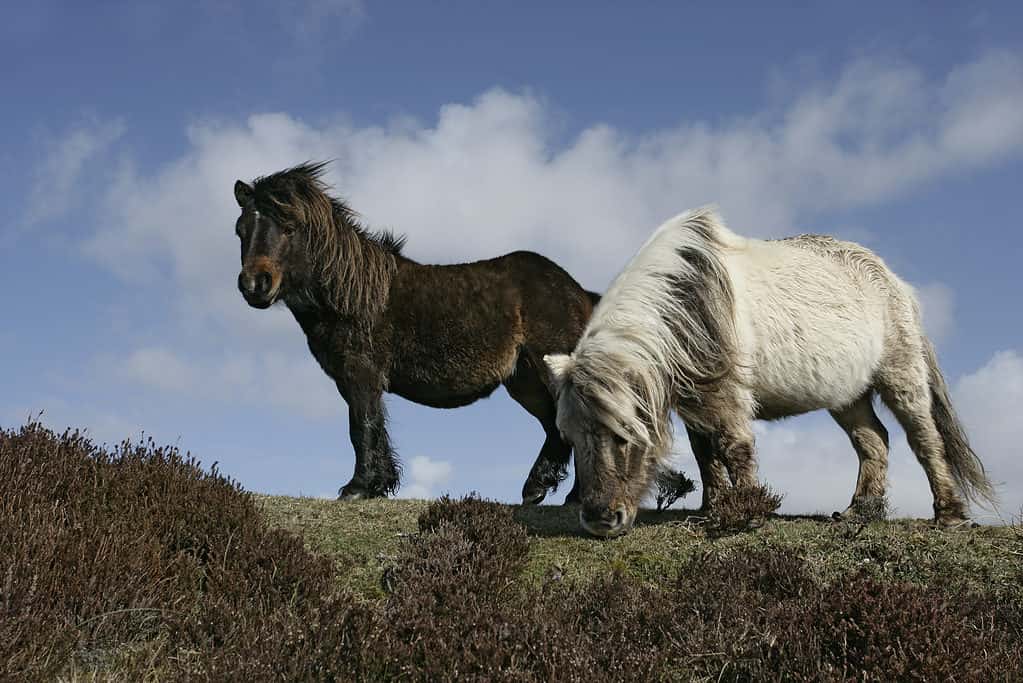
Eriskay ponies aren’t considered horses because they’re so docile, which makes them good therapy animals.
©Erni/Shutterstock.com
Eriskay ponies date back approximately 1,200 years though this estimate may be off by a few hundred years. There is evidence of domestication by Pictish, Celtic, and Norse cultures. They were bred to be friendly, and the harsh conditions of their homeland favored small and resilient animals.
These ponies were isolated on Scotland’s Outer Hebrides isles until the mid-19th century when they interbred with other horses. However, on the island of Eriskay, they remained unchanged.
They’re up to 13 hands tall, which makes them large ponies. They aren’t considered horses because they’re so docile, which makes them good therapy animals. They grow a long coat in the winter, which means they can live outdoors year-round.
Most existing ponies are still in Scotland. They were brought back from the brink of extinction, but there are still fewer than 500 alive today.
6. 2,000 Years As a Breed: Arabian Horses
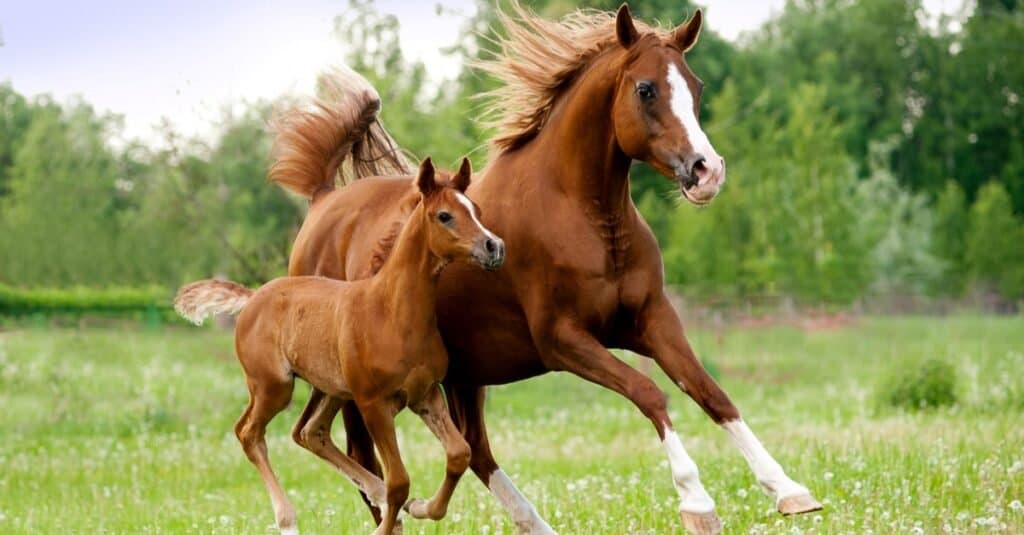
Arabian horses are one of the oldest breeds known and often considered the first domesticated horse breed.
©Olga_i/Shutterstock.com
Arabian horses were likely used in Rome, Ancient Egypt, and Greece. They originated with the Bedouin tribe in the Middle East. This makes them tolerant of dry and hot environments.
This breed of horse is the most influential in history. It’s a cornerstone to developing most of today’s horse breeds. People have been recording this horse for more than 2,000 years.
These are great horses for long endurance races. They grow up to 15 hands tall. Arabian horses are lively and fast.
5. 2,000 Years As a Breed: Norwegian Fjord Horses
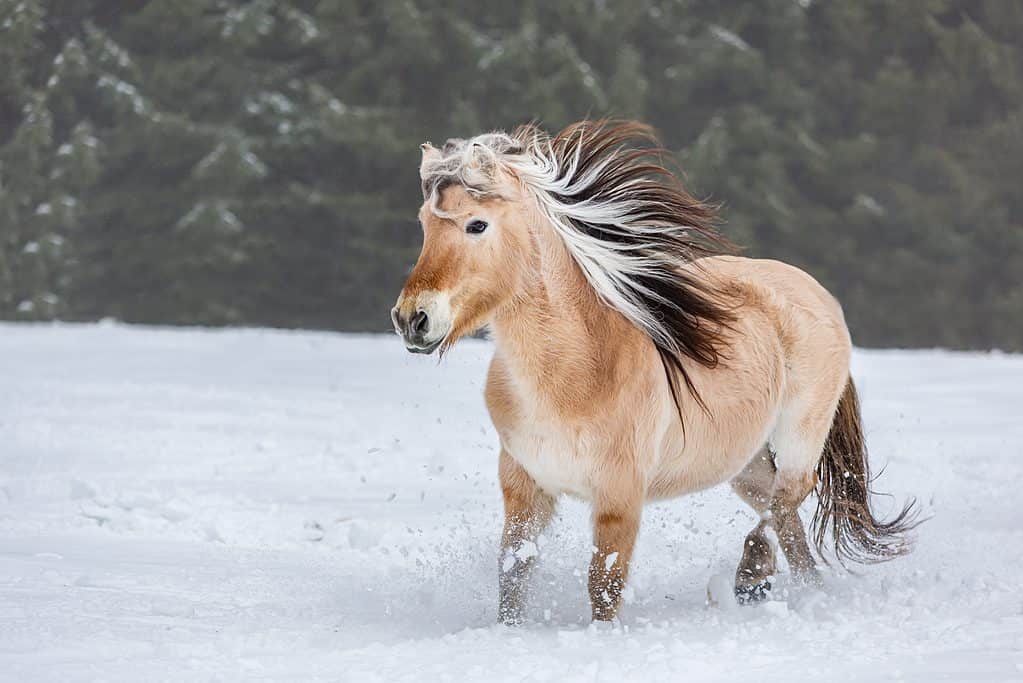
Norwegian Fjord horses are large and bulky because they were bred to work.
©Annabell Gsoedl/Shutterstock.com
Norwegian Fjord horses have been bred without mixing with other breeds for over 2,000 years. Their ancestry can be traced back to the Vikings that came to Norway around 4,000 years ago.
These horses are large and bulky because they were bred to work. Despite this, they’re still agile. They’re chosen as a horse now because they are good-tempered.
4. 2,000 Years As a Breed: Asturcon Pony

The Asturcon pony is a descendant of the Celtic pony and shares ancient ancestors with other Iberian ponies.
©Crispin la valiente/Shutterstock.com
The Asturcon pony lives in Northern Spain. It’s been documented for around 2,000 years, as it was mentioned by Pliny the Elder. It’s a descendant of the Celtic pony, and it shares ancient ancestors with other Iberian ponies.
While these ponies are endangered in the wild, they are well maintained in captivity. There are two distinct populations of Acturcon ponies that likely divided around the time of the Spanish Civil War in the late 1930s.
3. 3,000 Years As a Breed: Akhal-Teke Horses

The Akhal Teke has been renowned as cavalry mounts and racehorses for some 3,000 years.
©SunnyMoon/Shutterstock.com
Akhal-teke horses have most likely been around for thousands of years. They used to be called Nisean horses, and they’ve been around for at least 3,000 years. They’re probably descended from an ancient extinct breed called the Turkoman horse.
This is a Turkmen breed. There are around 6,600 of this breed living in Turkmenistan though there are some small populations kept by equine lovers around the world. They’re a part of the emblems and the paper money of Turkmenistan.
They’re also known as golden horses because their coat gives off a metallic gold shine in the sun. There are known inherited diseases in this horse breed caused by a lack of genetic diversity. These diseases are not fully understood.
2. 4,000 Years As a Breed: Mongolian Horses
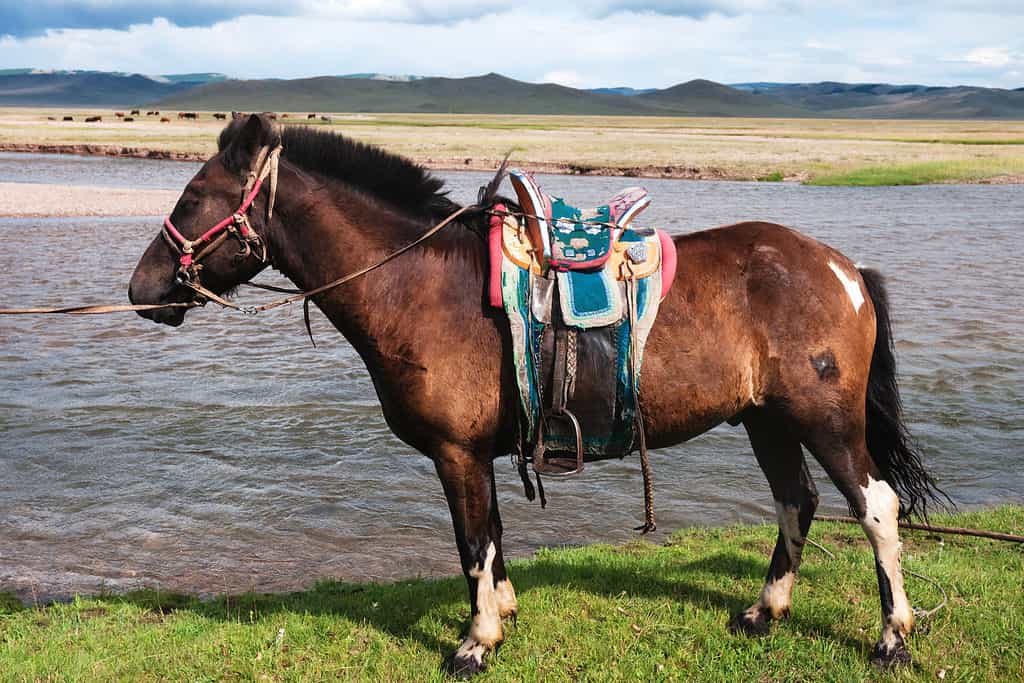
Mongolian horses date back to Genghis Khan’s rule of the Mongol Empire a little over a thousand years ago.
©Maxim Petrichuk/Shutterstock.com
Mongolian horses have been domesticated on the Eurasian Steppe for about 10,000 years. People began riding them about 4,000 years ago. These horses are bulky and hardy though they aren’t known for their speed.
This ancient horse breed is the national breed of Mongolia. It dates back to Genghis Khan’s rule of the Mongol Empire a little over a thousand years ago. They’re still important to the nomads in Mongolia, who keep more of these horses than there are people in their territory.
There are a wide variety of types of Mongolian horses originating from different places around the region. Each has its unique characteristics.
1. 11,000 Years As a Breed: Przewalski Horses
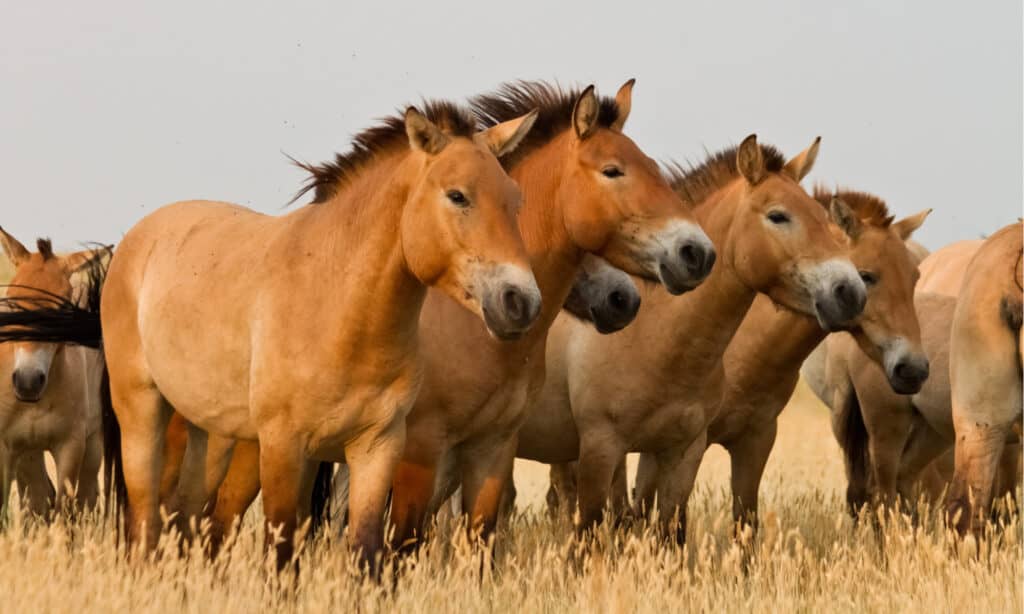
Przewalski’s horses are bulky and only reach a max height of 14 hands.
©Yantar/Shutterstock.com
Przewalski horses are an ancient horse breed that possibly goes back 11,000 years. They’re almost completely unrelated to today’s domestic horses, with which they haven’t shared an ancestor for tens of thousands of years. These horses are bulky and only reach a max height of 14 hands.
These horses were the last truly wild horses on earth. They lived in Mongolia and went extinct in the wild during the last half of the 20th century. There are still captive-bred individuals alive on earth today, and reintroduction efforts are succeeding in their natural range.
4 Extinct Horse Species
These are the 10 oldest horse breeds in the world but did you know that there are even older horses recorded? These 4 now-extinct ancient species were alive millions of years ago!
- The dawn horse: This was the very first horse species on Earth and alive 55.8-47.8 million years ago. It was only approximately a foot tall and interestingly had large canine teeth.
- The giant horse: Possibly the largest horse species ever, it was alive around 4.75 million-12,000 years ago. It weighed 2,600-3,300 pounds and had a shoulder height of 7 feet 5 inches.
- The tarpan: This free-ranging horse was found in the Russian steppe from the Early Pleistocene to the Holocene. It likely became fully extinct in 1909.
- The quagga: This zebra subspecies that was present in South Africa became extinct in the wild by 1878. In 1984, it was the first extinct animal to have its DNA analyzed.
Read more about these 4 fascinating extinct horse species here.
The World’s Oldest Horse
If you’re wondering how old the oldest individual horse in the modern world was, we have the answer.
The world’s oldest horse on record was named Old Billy, who lived for 62 years. Considering the average lifespan of a horse today is 25-30 years, Old Billy lived to an impressive age. From Lancashire in England, he was born sometime in 1760 and worked as a barge horse.
Another horse that lived way beyond the usual lifespan of a horse was Sugar Puff, who was born in 1951 and reached 56 years.
10 Oldest Horse Breeds in the World
These are the 10 of the oldest horse breeds on the planet:
| Rank | Horse Breed | Age |
|---|---|---|
| 1 | Przewalski Horses | 11,000 years old |
| 2 | Mongolian Horse | 4,000 years old |
| 3 | Akhal-Teke Horse | 3,000 years old |
| 4 | Asturcon Pony | 2,000 years old |
| 5 | Norwegian Fjord Horse | 2,000 years old |
| 6 | Arabian Horse | 2,000 years old |
| 7 | Eriskay Pony | 1,200 years old |
| 8 | Icelandic Horse | 1,000 years old |
| 9 | Exmoor Pony | 900 years old |
| 10 | Garrano Pony | 500 years old |
Honorable Mention:
The Caspian Horse, also known as moulek or pouseki horses, could possibly be 5,000 years old, but for about a thousand years, it was thought to be extinct.
Its country of origin is Iran, but it was found across the Middle East. This breed produces a small, placid trotting horse with grace and exceptional leaping abilities. A typical Caspian weighs 400-600 pounds and is 3.2-4.2 feet (97-127 cm) tall.
In 1957, an Iranian aristocrat in Tehran, Narcy Firouz, and his American-born wife, Louise Laylin, were looking for small, calm horses appropriate for training children how to ride. Hearing reports of tiny horses in some isolated villages above the Caspian Sea, they found a few unique, little horses and created a facility for the breed’s preservation.
The conformation of the Caspian horse is more like that of a horse than a pony. Its characteristics include a high croup, a vaulted brow, small legs, and a dense coat. Caspians can be just about any color. How lucky that this breed was re-discovered and saved!
The photo featured at the top of this post is © Yantar/Shutterstock.com
Sources
- MDPI, Available here: https://www.mdpi.com/2076-2615/11/7/1859
- Springer Nature , Available here: https://www.nature.com/articles/s41598-020-66232-1
- Oxford University Press, Available here: https://academic.oup.com/jhered/article/97/2/107/2187641
- Springer Nature , Available here: https://link.springer.com/article/10.1007/s10528-005-6775-1
Thank you for reading! Have some feedback for us? Contact the AZ Animals editorial team.




